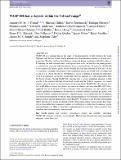WASP-80b has a dayside within the T-dwarf range
View/
Date
01/07/2015Author
Funder
Grant ID
ST/J001651/1
ST/I000666/1
PP/D000890/1
ST/K001515/1
ST/M001296/1
ST/G001006/1
PP/F000065/1
Keywords
Metadata
Show full item recordAbstract
WASP-80b is a missing link in the study of exo-atmospheres. It falls between the warm Neptunes and the hot Jupiters and is amenable for characterisation, thanks to its host star's properties. We observed the planet through transit and during occultation with Warm Spitzer. Combining our mid-infrared transits with optical time series, we find that the planet presents a transmission spectrum indistinguishable from a horizontal line. In emission, WASP-80b is the intrinsically faintest planet whose dayside flux has been detected in both the 3.6 and 4.5 $\mu$m Spitzer channels. The depths of the occultations reveal that WASP-80b is as bright and as red as a T4 dwarf, but that its temperature is cooler. If planets go through the equivalent of an L-T transition, our results would imply this happens at cooler temperatures than for brown dwarfs. Placing WASP-80b's dayside into a colour-magnitude diagram, it falls exactly at the junction between a blackbody model and the T-dwarf sequence; we cannot discern which of those two interpretations is the more likely. Flux measurements on other planets with similar equilibrium temperatures are required to establish whether irradiated gas giants, like brown dwarfs, transition between two spectral classes. An eventual detection of methane absorption in transmission would also help lift that degeneracy. We obtained a second series of high-resolution spectra during transit, using HARPS. We reanalyse the Rossiter-McLaughlin effect. The data now favour an aligned orbital solution and a stellar rotation nearly three times slower than stellar line broadening implies. A contribution to stellar line broadening, maybe macroturbulence, is likely to have been underestimated for cool stars, whose rotations have therefore been systematically overestimated. [abridged]
Citation
Triaud , A H M J , Gillon , M , Ehrenreich , D , Herrero , E , Lendl , M , Anderson , D R , Cameron , A C , Delrez , L , Demory , B-O , Hellier , C , Heng , K , Jehin , E , Maxted , P F L , Pollacco , D , Queloz , D , Ribas , I , Smalley , B , Smith , A M S & Udry , S 2015 , ' WASP-80b has a dayside within the T-dwarf range ' , Monthly Notices of the Royal Astronomical Society , vol. 450 , no. 3 , pp. 2279-2290 . https://doi.org/10.1093/mnras/stv706
Publication
Monthly Notices of the Royal Astronomical Society
Status
Peer reviewed
ISSN
0035-8711Type
Journal article
Description
AHMJT is a Swiss National Science Foundation (SNSF) fellow under grant number P300P2-147773. MG and EJ are Research Associates at the F.R.S-FNRS; LD received the support the support of the F.R.I.A. fund of the FNRS. DE, KH, and SU acknowledge the financial support of the SNSF in the frame of the National Centre for Competence in Research ‘PlanetS’. EH and IR acknowledge support from the Spanish Ministry of Economy and Competitiveness (MINECO) and the ‘Fondo Europeo de Desarrollo Regional’ (FEDER) through grants AYA2012-39612-C03-01 and ESP2013-48391-C4-1-R.Collections
Items in the St Andrews Research Repository are protected by copyright, with all rights reserved, unless otherwise indicated.
Related items
Showing items related by title, author, creator and subject.
-
A prospective new diagnostic technique for distinguishing eruptive and noneruptive active regions
Pagano, Paolo; Mackay, Duncan H.; Yardley, Stephanie L. (2019-09-26) - Journal articleActive regions are the source of the majority of magnetic flux rope ejections that become coronal mass ejections (CMEs). To identify in advance which active regions will produce an ejection is key for both space weather ... -
From dense hot Jupiter to low-density Neptune : the discovery of WASP-127b, WASP-136b, and WASP-138b
Lam, K. W. F.; Faedi, F.; Brown, D. J. A.; Anderson, D. R.; Delrez, L.; Gillon, M.; Hébrard, G.; Lendl, M.; Mancini, L.; Southworth, J.; Smalley, B.; Triaud, A. H. M.; Turner, O. D.; Hay, K. L.; Armstrong, D. J.; Barros, S. C. C.; Bonomo, A. S.; Bouchy, F.; Boumis, P.; Collier Cameron, A.; Doyle, A. P.; Hellier, C.; Henning, T.; Jehin, E.; King, G.; Kirk, J.; Louden, T.; Maxted, P. F. L.; McCormac, J. J.; Osborn, H. P.; Palle, E.; Pepe, F.; Pollacco, D.; Prieto-Arranz, J.; Queloz, D.; Rey, J.; Ségransan, D.; Udry, S.; Walker, S.; West, R. G.; Wheatley, P. J. (2017-03-01) - Journal articleWe report three newly discovered exoplanets from the SuperWASP survey. WASP-127b is a heavily inflated super-Neptune of mass 0.18 ± 0.02 MJ and radius 1.37 ± 0.04 RJ. This is one of the least massive planets discovered by ... -
The well-aligned orbit of Wasp-84b : evidence for disk migration of a hot Jupiter
Anderson, D. R.; Triaud, A. H. M. J.; Turner, O. D.; Brown, D. J. A.; Clark, B. J. M.; Smalley, B.; Cameron, A. Collier; Doyle, A. P.; Gillon, M.; Hellier, C.; Lovis, C.; Maxted, P. F. L.; Pollacco, D.; Queloz, D.; Smith, A. M. S. (2015-02-10) - Journal articleWe report the sky-projected orbital obliquity (spin–orbit angle) of WASP-84 b, a 0.69 planet in an 8.52 day orbit around a G9V/K0V star, to be λ = −0.3 ± 1.7°. We obtain a true obliquity of ψ = 17.3 ± 7.7° from a measurement ...

